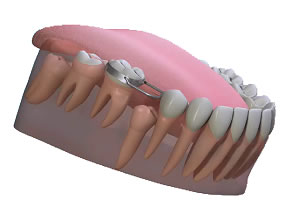Space Maintenance
 1. Why do children lose their primary teeth (baby teeth)?
1. Why do children lose their primary teeth (baby teeth)?
A primary tooth usually stays in until a permanent tooth underneath pushes it out and takes its place. Unfortunately, some children lose a baby tooth too soon. A tooth might be knocked out accidentally or removed because of dental disease. When a tooth is lost too early, your pediatric dentist may recommend a space maintainer to prevent future space loss and dental problems.
2.Why all the fuss? Baby teeth fall out eventually on their own!
Primary teeth are important to your child’s present and future dental health. They encourage normal development of the jaw bones and muscles. They save space for the permanent teeth and guide them into position. Remember: Some baby teeth are not replaced until a child is 12 or 14 years old.
When early primary tooth loss occurs, early, problems arise that affect the alignment of the permanent dentition. Opposing teeth can supraerupt, more distal teeth can drift and tip mesially, and more forward teeth can drift and tip distally. Altered tooth positions may include a space deficiency with loss of arch length and circumference, blocked or deflected eruption of permenent tetth, unattractive appearance,increase caries and periodontal disease, and other malocclusion problems.
3.How does a lost baby tooth cause problems for permanent teeth?
If a primary tooth is lost too soon, the teeth beside it may tilt or drift into the empty space. Teeth in the other jaw may move up or down to fill the gap. When adjacent teeth shift into the empty space, they create a lack of space in the jaw for the permanent teeth. Therefore, permanent teeth are crowded and come in crooked. If left untreated, the condition may require extensive orthodontic treatment.
4. What are space maintainers?
Space maintainers are appliances made of metal or plastic that are custom fit to your child’s mouth. They are small and unobtrusive in appearance. Most children easily adjust to them after the first few days.
The literature pertaining to the use of space maintainers specific to the loss of a particular primary tooth type include expert opinion, case reports, and details of appliance design. Treatment modalities may include, but are not limited to:
a. fixed appliances (eg, band and loop, crown and loop, passive lingual arch, distal shoe, Nance appliance, transpalatal arch);
b. removable appliances (eg, partial dentures, Hawley appliance).

Various types of space maintainers for different clinical situations
5. How does a space maintainer help?
Space maintainers hold open the empty space left by a lost tooth. They steady the remaining teeth, preventing movement until the permanent tooth takes its natural position in the jaw. It is more affordable -- and easier on your child -- to keep teeth in normal positions with a space maintainer than to move them back in place with orthodontic treatment.
6. What special care do space maintainers need?
Pediatric dentists have four rules for space maintainer care. First, avoid sticky sweets or chewing gum. Second, do not tug or push on the space maintainer with your fingers or tongue. Third, keep it clean with conscientious brushing and flossing. Fourth, continue regular dental visits.
Sources
http://www.aapd.org/media/Policies_Guidelines/G_DevelopDentition.pdf 2011-2012
Bell RA, Dean JA, McDonald RE, Avery DR. Managing the developing occlusion. In: Dean JA, Avery DR, McDonald RE. Dentistry for the child and adolescent. St. Louis, Mosby Elsevier, 9th ed., 2011, p: 550-613.





